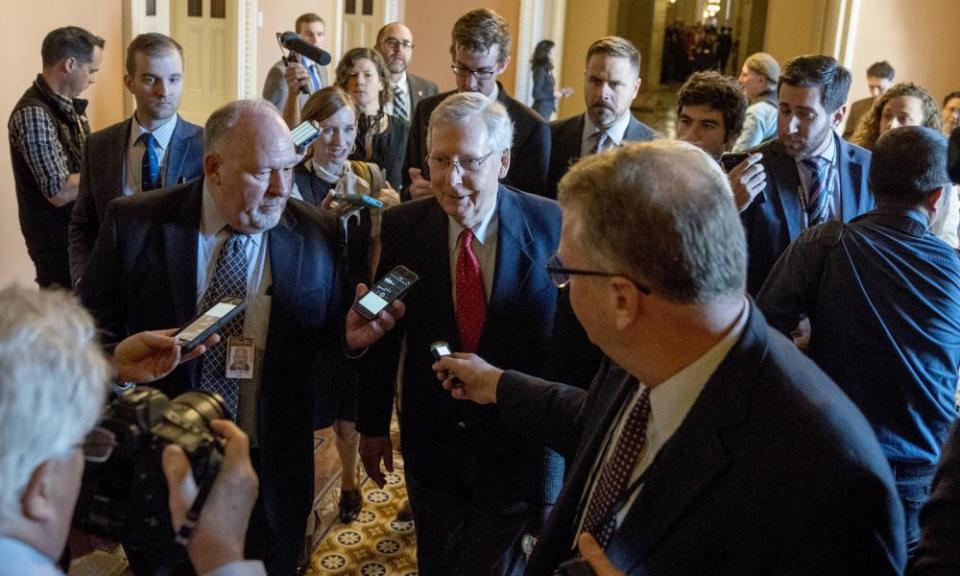What will feature in the final version of the Republican tax plan?
The House and Senate drafts, which help corporations and the rich and could leave millions without health insurance, must be reconciled into a single bill

All Republicans want for Christmas is tax reform – and they are poised to get it.
The Senate Republican tax overhaul that passed early on Saturday morning is filled with traditional GOP priorities, including big treats for corporations and the most affluent sections of society. But the bill will now need to be reconciled with the House-passed version.
The proposals differ on key provisions, setting up a challenge for lawmakers as they balance competing priorities between the chambers in a high-speed dash to draft a unified bill by Christmas.
Here’s a look at some of the measures that could be under consideration as Republicans finalize their tax overhaul:
Corporate tax rate
Slashing the corporate tax rate from 35% to 20% is at the centerpiece of both bills. Donald Trump has drawn a line in the sand at 20% and said he would not accept a higher rate, though some Republicans have proposed raising it gradually over time. There are also discrepancies between the plans on when the reduction would start. The Senate plan includes a one-year delay.
Individual tax rates
Republicans have touted their tax plan as major relief for the middle class. The Senate majority leader, Mitch McConnell, even promised that under the Senate plan no middle-class American would see a tax increase. He later said he “misspoke on that”. Independent analyses have found that the Senate plan would largely benefit America’s highest earners and offer mixed results for middle-income taxpayers.
The House and Senate plans differ in how they would affect individual tax rates. The House plan would condense income tax brackets from seven to four, while the Senate plan would keep seven brackets and reduce their rates. Under the Senate plan, at least some groups in every bracket would face a tax increase and that share would grow over time. Most of the provisions relating to individuals are set to expire in 2025.
Estate tax
The House GOP plan would eliminate the estate tax – or the death tax, to some critics – which affects people who leave a fortune of $5.49m or above to their children. After that there is a 40% tax. The House bill eliminates the tax entirely after 2024. The Senate bill doubles the amount wealthy parents can pass on to their children without being taxed.
State and local tax (Salt) deductions
One of the most contentious issues could be state and local tax deductions. The House and Senate bills eliminate the so-called Salt deductions and cap the deduction for property tax at $10,000. This piece of the plan would most hurt people living in high-tax, high-cost-of-living states, a majority of which elect Democrats, such as California and New York. Lawmakers from these states, especially in the House, are likely to push for more.
Pass-through businesses
Both plans seek to lower taxes on pass-through entities – businesses that are taxed at the individual rate rather than the corporate rate. The Senate tax plan allows owners of pass-through entities to deduct 23% of their business income, up from 17.4% in the original bill. The House created a new 25% tax for these entities and included provisions to block wealthy individuals from taking advantage of the lower rate.
Alternative minimum tax (AMT)
House lawmakers proposed eliminating the alternative minimum tax (AMT), which was introduced in 1969 to ensure the rich do not escape paying their fair share via tax loopholes. According to Tax Policy Center, the tax mainly affects households earning more than $500,000. At the last minute, Senate Republicans chose to keep the taxes, with some adjustments.
Individual mandate
The Senate tax plan would repeal the Affordable Care Act’s individual mandate, which requires all Americans to have health insurance or face a penalty. Including the provision in the tax bill is projected to result in 13 million more uninsured people and a 10% increase in premiums. The House plan does not touch the healthcare law.
Political activism by churches
The House version of the tax bill includes language that would repeal a ban on political activism by churches and other not-for-profit groups. This would allow not-for-profit organizations to support political candidates. In a bid to expand his reach with Christian conservatives during the presidential campaign, Trump vowed to repeal the 1954 law, known as the Johnson amendment. He has repeated this promise as president.
Higher education
Across the country, graduate and PhD students have been protesting against a provision of the House bill that would turn their tuition waivers into taxable income. Many graduate and PhD students receive free tuition – and stipends – in exchange for teaching or conducting research. Currently, students are only taxed on the stipends they receive. Students have argued that the provision could have a dramatic impact on what they owe to the federal government, making it impossible to continue to pursuing their degrees.
Legal rights to fetuses
The House bill includes language that would allow parents to set up 529 plans – education savings accounts intended to allow families to put money aside for a child’s higher education – for a “child in utero”. In fact, parents are already able to do this but the provision would achieve an important victory for anti-abortion activists by explicitly recognizing unborn children in federal law.

